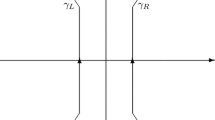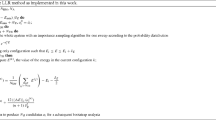Abstract
We develop an efficient algorithmic approach for approximate counting and sampling in the low-temperature regime of a broad class of statistical physics models on finite subsets of the lattice \(\mathbb {Z}^d\) and on the torus \((\mathbb {Z}/n\mathbb {Z})^d\). Our approach is based on combining contour representations from Pirogov–Sinai theory with Barvinok’s approach to approximate counting using truncated Taylor series. Some consequences of our main results include an FPTAS for approximating the partition function of the hard-core model at sufficiently high fugacity on subsets of \(\mathbb {Z}^d\) with appropriate boundary conditions and an efficient sampling algorithm for the ferromagnetic Potts model on the discrete torus \((\mathbb {Z}/n\mathbb {Z})^d\) at sufficiently low temperature.






Similar content being viewed by others
Notes
This means \(\frac{|\partial ^{\mathrm{in}}\varLambda _{n}|}{|\varLambda _{n}|}\rightarrow 0\), see [23, Section 3.2.1].
We could consider only vertices x such that \(d_\infty (x, \varLambda ^c)>1\), but it does no harm to include the others.
References
Adams, S., Briceño, R., Marcus, B., Pavlov, R.: Representation and poly-time approximation for pressure of \(\mathbb{Z}^2\) lattice models in the non-uniqueness region. J. Stat. Phys. 162(4), 1031–1067 (2016)
Barvinok, A.: Computing the partition function for cliques in a graph. Theory Comput. 11(13), 339–355 (2015)
Barvinok, A.: Computing the permanent of (some) complex matrices. Found. Comput. Math. 16(2), 329–342 (2016)
Barvinok, A.: Combinatorics and complexity of partition functions. vol. 276, Springer, Cham (2016). https://doi.org/10.1007/978-3-319-51829-9
Barvinok, A., Regts, G.: Weighted counting of solutions to sparse systems of equations. Comb. Probab. Comput (2019). https://doi.org/10.1017/S0963548319000105
Barvinok, A., Soberón, P.: Computing the partition function for graph homomorphisms with multiplicities. J. Comb. Theory Ser. A 137, 1–26 (2016)
Baxter, R.J.: Hard hexagons: exact solution. J. Phys. A Math. Gen. 13(3), L61 (1980)
Beyer, T., Hedetniemi, S.M.: Constant time generation of rooted trees. SIAM J. Comput. 9(4), 706–712 (1980)
Bezáková, I., Galanis, A., Goldberg, L.A., Štefankovič, D.: Inapproximability of the independent set polynomial in the complex plane. In: Proceedings of the Fiftieth Annual ACM Symposium on Theory of Computing, STOC 2018, pp. 1234–1240. ACM (2018)
Björklund, A., Husfeldt, T., Kaski, P., Koivisto, M.: Computing the Tutte polynomial in vertex-exponential time. In: Proceedings of the Forty-ninth Annual Symposium on Foundations of Computer Science, FOCS 2008, pp. 677–686. IEEE (2008)
Blanca, A., Chen, Y., Galvin, D., Randall, D., Tetali, P.: Phase coexistence for the hard-core model on \(\mathbb{Z}^2\). Comb. Probab. Comput. 28(1), 1–22 (2019)
Blanca, A., Sinclair, A.: Random-cluster dynamics in \(\mathbb{Z}^2\). Probab. Theory Relat. Fields 168(3–4), 821–847 (2017)
Borgs, C., Chayes, J., Kahn, J., Lovász, L.: Left and right convergence of graphs with bounded degree. Random Struct. Algorithms 42(1), 1–28 (2013)
Borgs, C., Chayes, J.T., Dyer, M., Tetali, P.: On the sampling problem for H-colorings on the hypercubic lattice. In: Graphs, Morphisms, and Statistical Physics: DIMACS Workshop Graphs, Morphisms and Statistical Physics, March 19–21, 2001, DIMACS Center, vol. 63, p. 13. American Mathematical Soc. (2004)
Borgs, C., Chayes, J.T., Frieze, A., Kim, J.H., Tetali, P., Vigoda, E., Vu, V.H.: Torpid mixing of some Monte Carlo Markov chain algorithms in statistical physics. In: Proceedings of the Fourtieth Annual Symposium on Foundations of Computer Science, FOCS 1999, pp. 218–229. IEEE (1999)
Borgs, C., Chayes, J.T., Tetali, P.: Tight bounds for mixing of the Swendsen–Wang algorithm at the Potts transition point. Probab. Theory Relat. Fields 152(3–4), 509–557 (2012)
Borgs, C., Imbrie, J.Z.: A unified approach to phase diagrams in field theory and statistical mechanics. Commun. Math. Phys. 123(2), 305–328 (1989)
Borgs, C., Kotecký, R., Miracle-Solé, S.: Finite-size scaling for Potts models. J. Stat. Phys. 62(3–4), 529–551 (1991)
Cai, J.Y., Galanis, A., Goldberg, L.A., Guo, H., Jerrum, M., Štefankovič, D., Vigoda, E.: # BIS-hardness for 2-spin systems on bipartite bounded degree graphs in the tree non-uniqueness region. J. Comput. Syst. Sci. 82(5), 690–711 (2016)
Dobrushin, R.: Estimates of semi-invariants for the Ising model at low temperatures. Transl. Am. Math. Soc. Ser. 2(177), 59–82 (1996)
Dyer, M., Goldberg, L.A., Greenhill, C., Jerrum, M.: The relative complexity of approximate counting problems. Algorithmica 38(3), 471–500 (2004)
Fernández, R., Procacci, A.: Cluster expansion for abstract polymer models. New bounds from an old approach. Commun. Math. Phys. 274(1), 123–140 (2007)
Friedli, S., Velenik, Y.: Statistical Mechanics of Lattice Systems: A Concrete Mathematical Introduction. Cambridge University Press, Cambridge (2017)
Galanis, A., Štefankovič, D., Vigoda, E.: Inapproximability of the partition function for the antiferromagnetic Ising and hard-core models. Comb. Probab. Comput. 25(4), 500–559 (2016)
Galanis, A., Stefankovic, D., Vigoda, E., Yang, L.: Ferromagnetic Potts model: refined #-BIS-hardness and related results. SIAM J. Comput. 45(6), 2004–2065 (2016)
Galvin, D., Kahn, J.: On phase transition in the hard-core model on \(\mathbb{Z}^d\). Combin. Probab. Comput. 13(2), 137–164 (2004)
Gamarnik, D., Katz, D.: Sequential cavity method for computing free energy and surface pressure. J. Stat. Phys. 137(2), 205–232 (2009)
Gheissari, R., Lubetzky, E.: Mixing times of critical two-dimensional Potts models. Commun. Pure Appl. Math. 71(5), 994–1046 (2018)
Goldberg, L.A., Jerrum, M.: Approximating the partition function of the ferromagnetic Potts model. J. ACM 59(5), 25 (2012)
Grimmett, G.R.: The Random-Cluster Model, 2nd edn. Springer, Berlin (2006)
Guo, H., Jerrum, M.: Random cluster dynamics for the Ising model is rapidly mixing. Ann. Appl. Probab. 28(2), 1292–1313 (2018). https://doi.org/10.1214/17-AAP1335
Harvey, N.J., Srivastava, P., Vondrák, J.: Computing the independence polynomial: from the tree threshold down to the roots. In: Proceedings of the Twenty-Ninth Annual ACM-SIAM Symposium on Discrete Algorithms, pp. 1557–1576. SIAM (2018)
Jauslin, I., Lebowitz, J.L.: High-fugacity expansion and crystalline ordering for non-sliding hard-core lattice particle systems. (2017) arXiv preprint arXiv:1708.01912
Jenssen, M., Keevash, P., Perkins, W.: Algorithms for #BIS-hard problems on expander graphs. In: Proceedings of the Thirtieth Annual ACM-SIAM Symposium on Discrete Algorithms, pp. 2235–2247 (2019) Full version available at arXiv:1807.04804
Jerrum, M., Sinclair, A.: Polynomial-time approximation algorithms for the Ising model. SIAM J. Comput. 22(5), 1087–1116 (1993)
Jerrum, M.R., Valiant, L.G., Vazirani, V.V.: Random generation of combinatorial structures from a uniform distribution. Theor. Comput. Sci. 43, 169–188 (1986)
Joyce, G.: On the hard-hexagon model and the theory of modular functions. Phil. Trans. R. Soc. Lond. A 325(1588), 643–702 (1988)
Kotecký, R., Preiss, D.: Cluster expansion for abstract polymer models. Commun. Math. Phys. 103(3), 491–498 (1986)
Laanait, L., Messager, A., Miracle-Solé, S., Ruiz, J., Shlosman, S.: Interfaces in the Potts model I: Pirogov–Sinai theory of the Fortuin–Kasteleyn representation. Commun. Math. Phys. 140(1), 81–91 (1991)
Lee, T.D., Yang, C.N.: Statistical theory of equations of state and phase transitions. II. Lattice gas and Ising model. Phys. Rev. 87(3), 410 (1952)
Liu, J., Lu, P.: FPTAS for #BIS with degree bounds on one side. In: Proceedings of the Forty-seventh Annual ACM Symposium on Theory of Computing, STOC 2015, pp. 549–556. ACM (2015)
Liu, J., Sinclair, A., Srivastava, P.: The Ising partition function: Zeros and deterministic approximation. J. Stat. Phys. 174, 287–315 (2019)
Lubetzky, E., Martinelli, F., Sly, A., Toninelli, F.L.: Quasi-polynomial mixing of the 2D stochastic Ising model with “plus” boundary up to criticality. J. Eur. Math. Soc. 15, 339 (2013)
Otter, R.: The number of trees. Ann. Math. 49, 583–599 (1948)
Patel, V., Regts, G.: Computing the number of induced copies of a fixed graph in a bounded degree graph. Algorithmica 81(5), 1844–1858 (2019)
Patel, V., Regts, G.: Deterministic polynomial-time approximation algorithms for partition functions and graph polynomials. SIAM J. Comput. 46(6), 1893–1919 (2017)
Peled, R., Samotij, W.: Odd cutsets and the hard-core model on \(\mathbb{Z}^d\). Annales de l’Institut Henri Poincaré, Probabilités et Statistiques 50(3), 975–998 (2014)
Peters, H., Regts, G.: On a conjecture of Sokal concerning roots of the independence polynomial. Michigan Math. J. 68(1), 33–55 (2019)
Pirogov, S.A., Sinai, Y.G.: Phase diagrams of classical lattice systems. Theor. Math. Phys. 25(3), 1185–1192 (1975)
Pirogov, S.A., Sinai, Y.G.: Phase diagrams of classical lattice systems continuation. Theor. Math. Phys. 26(1), 39–49 (1976)
Randall, D.: Slow mixing of Glauber dynamics via topological obstructions. In: Proceedings of the Seventeenth Annual ACM-SIAM Symposium on Discrete Algorithms, SODA 2006, pp. 870–879. Society for Industrial and Applied Mathematics (2006)
Randall, D., Wilson, D.: Sampling spin configurations of an ising system. In: Proceedings of the Tenth Annual ACM-SIAM Symposium on Discrete Algorithms, SODA 1999, pp. 959–960. Society for Industrial and Applied Mathematics (1999)
Scott, A.D., Sokal, A.D.: The repulsive lattice gas, the independent-set polynomial, and the Lovász local lemma. J. Stat. Phys. 118(5–6), 1151–1261 (2005)
Shearer, J.B.: On a problem of Spencer. Combinatorica 5(3), 241–245 (1985)
Sinclair, A., Jerrum, M.: Approximate counting, uniform generation and rapidly mixing Markov chains. Inf. Comput. 82(1), 93–133 (1989)
Sly, A.: Computational transition at the uniqueness threshold. In: Proceedings of the Fifty-first Annual IEEE Symposium on Foundations of Computer Science, FOCS 2010, pp. 287–296. IEEE (2010)
Sly, A., Sun, N.: Counting in two-spin models on d-regular graphs. Ann. Probab. 42(6), 2383–2416 (2014)
Timár, Á.: Boundary-connectivity via graph theory. Proc. Am. Math. Soc. 141(2), 475–480 (2013)
Tracy, C.A., Grove, L., Newman, M.: Modular properties of the hard hexagon model. J. Stat. Phys. 48(3–4), 477–502 (1987)
Ullrich, M.: Rapid mixing of Swendsen–Wang dynamics in two dimensions. Diss. Math. 502, 1–64 (2014)
Weitz, D.: Counting independent sets up to the tree threshold. In: Proceedings of the Thirty-Eighth Annual ACM Symposium on Theory of Computing, STOC 2006, pp. 140–149. ACM (2006)
Zahradník, M.: An alternate version of Pirogov–Sinai theory. Commun. Math. Phys. 93(4), 559–581 (1984)
Acknowledgements
WP and GR thank Ivona Bezáková, Leslie Goldberg, and Mark Jerrum for organizing the 2017 Dagstuhl seminar on computational counting and Jan Hladkỳ for organizing the 2018 workshop on graph limits in Bohemian Switzerland. Both meetings provided essential inspiration and discussion leading to this work. TH thanks Roman Kotecký for helpful discussions. We thank Eric Vigoda, Matthew Jenssen, and Reza Gheissari for detailed comments on a draft of the paper. We are moreover grateful to the anonymous referees for their helpful suggestions.
Author information
Authors and Affiliations
Corresponding author
Additional information
Publisher's Note
Springer Nature remains neutral with regard to jurisdictional claims in published maps and institutional affiliations.
Tyler Helmuth: Supported by EPSRC Grant EP/P003656/1.
Will Perkins: Supported in part by EPSRC Grant EP/P009913/1 and NSF Career Award DMS-1847451.
Guus Regts: Supported by an NWO Veni Grant.
Rights and permissions
About this article
Cite this article
Helmuth, T., Perkins, W. & Regts, G. Algorithmic Pirogov–Sinai theory. Probab. Theory Relat. Fields 176, 851–895 (2020). https://doi.org/10.1007/s00440-019-00928-y
Received:
Revised:
Published:
Issue Date:
DOI: https://doi.org/10.1007/s00440-019-00928-y
Keywords
- Approximate sampling
- Approximation algorithms
- FPTAS
- Discrete spin systems
- Pirogov–Sinai theory
- Cluster expansion




